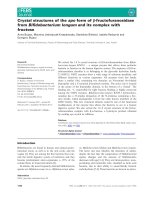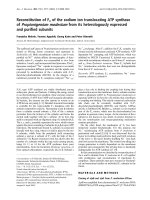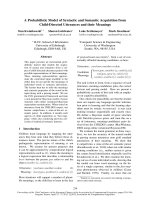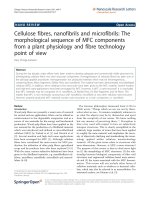Fractionation of secondary metabolites from Tulsi (Ocimum sanctum) and aloe vera (Aloe barbadensis Mill.) and their antifungal activity against aspergillus niger and sclerotium rolfsii
Bạn đang xem bản rút gọn của tài liệu. Xem và tải ngay bản đầy đủ của tài liệu tại đây (344.95 KB, 8 trang )
Int.J.Curr.Microbiol.App.Sci (2020) 9(5): 445-452
International Journal of Current Microbiology and Applied Sciences
ISSN: 2319-7706 Volume 9 Number 5 (2020)
Journal homepage:
Original Research Article
/>
Fractionation of Secondary Metabolites from Tulsi (Ocimum sanctum)
and Aloe Vera (Aloe barbadensis Mill.) and their Antifungal Activity
against Aspergillus niger and Sclerotium rolfsii
A. V. Chinche, R. M. Gade*, A. N. Shinde, M. T. Vairagade and K. V. Kendhale
Vasantrao Naik College of Agricultural Biotechnology, Yavatmal, India
*Corresponding author
ABSTRACT
Keywords
Secondary
metabolites,
Ocimum sanctum,
Aloe barbadensis
Mill, Aspergillus
niger, Sclerotium
rolfsii,
Article Info
Accepted:
05 April 2020
Available Online:
10 May 2020
An investigation was undertaken on fractionation of secondary metabolites from Ocimum sanctum
and Aloe barbadensis Mill to check their antifungal activity against Aspergillus niger and Sclerotium
rolfsii. Isolation of secondary metabolites was done by cold percolation and soxhlet extraction
method with Methanol. Cold percolation method was found effective to get more phytochemicals.
Analysis was done to check the presence of phytochemicals likes Alkaloids, Tannins, Saponins,
Phenols, Flavonoids, Glycosides, Steroids and Terpenoids. Also qualitative tests viz. detection of
Alkaloids was carried out by Wagner’s reagent, Glycosides by Keller-killiani test, steroids by
concentrated H2SO4, Tannins by 0.1N HCl, Saponins by distilled water, Phenol by Ferric chloride,
Flavonoids by concentrated H2SO4. Except phenol all components were present in both Ocimum
sanctum and Aloe barbadensis Mill leaves extract. Presence of these components was determined by
colour change or foam development after adding reagents into extract. Thin layer chromatography
was done for the separation of different chemical constituents present in methanolic extracts. During
standardization of eight different solvent systems Chloroform: Ethyl acetate : Acetic acid (50:50:1
v/v) found effective for the separation of Ocimum sanctum and Toluene : Ethyl acetate (93:7 v/v)
for Aloe barbadensis Mill for the seperation of different components. scrapping of desired bands on
TLC of partially purified compound used to check the antifungal activity against Aspergillus niger
and Sclerotium rolfsii using poisoned food method. Different concentrations i.e. 20 mg, 40 mg, and
60 mg were taken, amongst 60 mg showed significant growth inhibition as against 20 mg.
phytochemical available out of that nearly
around ten thousand are plant secondary
metabolites. These chemicals are having a
defensive role and well established in the
management of human diseases but their role
in the management of plant diseases is still
lacking (Satish et al., 2007 and Taiga et al.,
2008). Phenols, Flavonoids, Quinones,
Tannins, Alkaloids, Saponins, Sterols and
Introduction
Secondary
metabolites
like
Tannins,
Terpenoids, Alkaloids, Flavonoids play an
important
role
in
plant
protection.
Pharmaceuticals and pesticide industries are
blessed with these economically important
organic compounds (Patel and Jasrai, 2009;
Wavare et al., 2017). There are many
445
Int.J.Curr.Microbiol.App.Sci (2020) 9(5): 445-452
Terpenoids available in higher plants having a
rich diversity of bioactive secondary
substances giving the advantage to explore
alternative sources to chemicals and
supplementary benefit of their eco-friendly
nature (Tripathi and Dubey, 2004, Wavare et
al., 2015; More et al., 2017).
Soxhlet extraction
The leaf samples were dried at a temperature
of about 40-45°c. 40 g of fine powder of plant
material was placed in a small size of muslin
cloth bag in a soxhlet apparatus. The glycerin
was kept at the joint of the extraction chamber
and also at the mouth of the condenser to stop
the leakage. The extraction chamber was
filled with 250 ml of Methanol as a solvent
through the open end so that the powder was
properly dipped in it. The extraction was
carried out until the extract was colourless.
The extracts were filtered through Whatman
filter paper no.1. The filtrate was then
evaporated at 40°c and stored at 4°c for
further analysis.
Aloe vera is rich in Vitamins, Minerals,
Enzymes, Sugars, Phenolic compounds,
Lignin, Saponins, Sterol and Amino acids.
The inner gel of the leaves has many
biological properties with the major
secondary
metabolites
like
Anthraquinones and tricyclic aromatic
quinines (Maharjan et al., 2015).
Similarly, the genus Ocimum is known as
King of herbs and recognized for its
therapeutic use having a lot of economic,
nutritional,
industrial
and
medicinal
properties. Alkaloids are anti-oxidant and
antimicrobial, Flavanoids and Phenolics are
antimicrobial and antifungal, Tannins are
anti-inflammatory and antioxidant (Simon et
al., 1990). Aspergillus niger and Sclerotium
rolfsii caused enormous losses in Agriculture
crops.
Cold percolation
The leaves samples were dried at the
temperature of about 40-45°c for 3-4 days and
made fine powder out of that 20 g powder
was added into a conical flask containing 200
ml of Methanol as the solvent. This was kept
at room temperature for about 72 hrs. The
stirring of solution was done every 4-5 hrs.
After that solution was filtered out by using
Whatman filter paper. Finally, filtrate was
transferred into an oven at the temperature of
about 60-62°c which is the melting point of
Methanol to evaporate the solvent and got
solid extract. The extract was kept in a
refrigerator at 4°c to be used for further
studies. Noted down the weight of each Petri
dish prior to drying of the extracts and after
drying too. The calculated weight of the
extracts from that difference. The yield of the
extract was calculated in grams and converted
into a percentage.
Therefore, the present investigation is an
attempt to explore the possibility of utilizing
such huge biological material against plant
pathogens. The results will open a new
horizon in the field of Agriculture. The
present study was, therefore, aimed at
evaluating the phytochemical potential and
antifungal activity of Ocimum sanctum and
Aloe barbadensis Millmethanolic leaf extracts
against plant pathogens.
Materials and Methods
Thin layer chromatography
Isolation and maintenance of fungal pathogen
cultures were done by using Potato Dextrose
Agar (PDA). The pure culture of these isolates
was maintained on slants for further studies.
Thin layer chromatography was carried out to
know the chemical profile of methanolic
extract of Ocimum sanctum L. and Aloe
446
Int.J.Curr.Microbiol.App.Sci (2020) 9(5): 445-452
barbadensis Mill. TLC plates were prepared
with 25 g of silica gel-G (Hi media,
Manufactured India) mixed with 50 ml of
distilled water and the slurry formed was
uniformly spread with the use of spreader on
TLC plates of 0.25 mm. The plates were
allowed to dry at room temperature and
heated in an oven at 100˚c for 2 hrs.
Cardio glycosides, Saponins, Alkaloids,
Steroids, Terpenoids, Flavonoids, Tannins
and Phenolic compounds by following the
methods given by Trease and Evans (1978).
Test for detection of alkaloid
1 ml of extract was taken in a test tube,
followed by the addition of 1 ml of Wagner’s
reagent. The appearance of brown flocculent
and precipitation reveals the presence of
Alkaloids.
Standardization of solvent system
Sample of the crude extract Ocimum sanctum
L. and Aloe barbadensis Mill. Leaves extract
were diluted in the respective solvent. The
prepared TLC plates were marked 1 cm from
bottom and 10 ul each sample was applied on
TLC plates at equal distance with the help of
capillary tubes. For separation of maximum
bands on TLC plates, different solvent
systems were used according to polarity and
from that Chloroform: Ethyl acetate : Acetic
acid (50:50:1) and Toluene : Ethyl acetate
(93:7), for Ocimum sanctum L. and Aloe
barbadensis Mill. respectively extract was
selected as standard solvent system.
Test for detection of tannins
1ml of the extract was taken in a test tube, and
then 1 ml of 0.1% Ferric chloride-containing
0.1N HCL was added. The appearance of
blue-black coloration indicates the presence
of Tannins.
Test for detection of saponins
The extract was mixed with 5 ml distilled
water and then agitated in a graduated
cylinder for 15 min. The presence of Saponins
confirmed with the presence of foam.
TLC plates were kept in chromatography
chambers, containing Chloroform: Ethyl
acetate : Acetic acid (50:50:1), Toluene :
Ethyl acetate (93:7) as a solvent system for
respective leaves extract and allowed to run
so that it can reach to 3/4th position. The
developed chromatogram on TLC plates was
allowed to air dry and observed under visible
UV light. The colour of the bands was noted
and the Rf value (Relative front) of separated
bands was calculated by measuring the
distance traveled by solute and the solvent.
Test for phenols
Ferric chlorides were added to 1 ml of extract
in a test tube. The development of a dark
green color indicates the presence of phenols.
Test for flavonoids
In 1 ml of extract, 1 ml of dilute ammonia
solution was added followed by the addition
of concentrated H2SO4 dropwise. A yellow
coloration observed indicates the presence of
Flavonoids.
Preliminary phytochemical screening of
leaves extracts
Preliminary phytochemical analysis of
methanolic extracts from Ocimum sanctum L.
and Aloe barbadensis Mill were performed
for analysis of different phytochemical like
Test for glycosides (keller-kiliani test)
About 1ml of the extract was treated with 1
ml of Glacial acetic acid containing one drop
447
Int.J.Curr.Microbiol.App.Sci (2020) 9(5): 445-452
of Ferric chloride solution. This was underlaid
with 1 ml of concentrated H2SO4. A brown
ring at the interface indicates the presence of
Glycosides.
information about the interfering substances
are important in the process (Stalikas et al.,
2007). In this experiment Ocimum sanctum L.
and Aloe barbadensis Millextracts were
obtained by using Methanol. The Methanol
was the best
solvent to give sufficient
extraction yield and was the most capable to
extract more
substances that preferably
dissolved in Methanol. Maximum extraction
yield of Ocimum sanctum L. (15.99%) and
Aloe barbadensis Mill. (16.38%) was
obtained in Methanol (Ncube and Okoh,
2008., Gurjar et al., 2012; Wavare et al.,
2016).
Test for steroids
About 2 ml of Acetic anhydride was added to
1 ml crude extract of plant sample with 2 ml
H2SO4. The presence of Steroids confirmed
when colour change from violet to blue or
green.
In vitro evaluation of plant extracts by
poisoned food technique on PDA
medium
This indicates that the extraction yield of pure
Methanol (15.99% and 16.38%) increases due
to polarity of the solvent used in extraction.
The solubility of proteins and carbohydrates
in Methanol may be attributed to get more
extraction yield (Zieliński, 2000). The results
of this study are also in agreement with the
extraction yields obtained from medicinal
plants (Sultana, 2009).
The efficacy of Methanol extracts of Ocimum
sanctum L. and Aloe barbadensis Mill whole
plant extracts at 20, 40, and 60 mg/lit were
tested against Sclerotium rolfsii in vitro under
condition following poisoned food technique
on PDA medium. The suspension of 20, 40,
and 60 mg/lit of methanolic crude extracts
were poured separately in Petri plates
containing 20 ml sterilized PDA medium.
Thin layer chromatography (TLC)
The plates were rotated for some time for
uniform mixing of the crude extract with
medium and then allowed for solidification.
Three replications for each treatment were
used. All the plates were inoculated
individually with 5 mm
diameter discs of
the test fungal cultures and then incubated at
28±2°C until the control plates reached full
growth. The percent of growth inhibition of
test fungus was calculated by using a formula
suggested by Vincent (1947).
Each sample of the crude extracts of Ocimum
sanctum L. and Aloe barbadensis Mill. was
diluted in distilled water. The prepared TLC
plates were marked 1 cm from the bottom and
10 µl each sample was applied on TLC plates
at equal distance with the help of capillary
tubes. For the separation of maximum bands
on TLC plates, different solvent system were
used according to polarity and from that
Chloroform : Ethyl acetate : Acetic acid
(50:50:1 v/v) and Toluene : Ethyl acetate
(93:7 v/v) was selected as a standard solvent
systems for
Ocimum sanctum L. and Aloe
barbadensis Mill. Thin layer chromatography
was carried out for the efficient separation of
different chemical constituents present in
Methanol extracts and Rf values and colour of
separated bands in different solvent systems
under UV- transilluminator were noted.
Results and Discussion
Extraction yield
Extraction is the major step for obtaining
phytochemicals from plants. Standardization
of extraction and accurate use of solvent
448
Int.J.Curr.Microbiol.App.Sci (2020) 9(5): 445-452
of the non-polar compounds soluble at certain
extent in methanol: chloroform in solvent
system may boost the extraction yield if
compound is strictly hydrophobic. Low
boiling point may be the reason to get
extraction and concentration of bioactive
compounds in soxhlet extraction.For Aloe
barbadensis Mill. Different solvent systems
(Table 2) were standardized. Among all other
solvent systems, found best for methanolic
extracts of Aloe barbadensis Millwas
Toluene: Ethyl acetate (93:7 v/v). The RF
values obtained for these solvent systems
were 0.69, 0.25, 0.03 (Table 2). More et al.,
2016 observed the most promising solvent
system for methanolic extracts of A.
marmelose run under petroleum ether: ethyl
acetate (02:01). The results are also in
confirmation
with
the
findings
of
Masuduzzaman et al., (2008) who observed
separated compounds of all amanda leaf
aqueous extract on TLC plate eluted with
Hexane: Benzeen (1:1) and Benzene: Ethyl
acetate, respectively. Polar solvent system
used in the experiment may be the reason for
the separation of maximum number of
compounds from methanolic extracts.
Standardization of solvent system
Various solvent systems were screened for
efficient separation of bands according to
polarity. Total of 8 solvent systems were used
in the present investigation to know most
suitable
solvent system for the separation
of compounds in the methanolic extract of
Ocimum sanctum L. and Aloe barbadensis
Mill. The Rf values and colour of the
separated bands in different solvent systems
under UV-transilluminator are summarized in
Table 1 and Table 2. There were significant
differences according to solvent system in the
number of bands and their Rf values in
methanolic extracts. Among all the tested
solvent systems, the Rf values of the best
solvent system for the methanolic extract of
Ocimum sanctum L. run under Chloroform :
Ethyl
acetate : Acetic acid (50:50:1 v/v)
was found 0.78, 0.66, and 0.12 with separated
and clear bands. These observations are in
accordance with the findings of Shitole et al.,
2017 who carried out methonolic extraction
of P. corylifolia seed using Toluene : Ethyl
acetate : Methanol (20:04:02 v/v) solvent
system. It is seen that Methanol not only best
for extraction of polar compounds but some
Table.1 Standardization of solvent system for methanol extract of Ocimum sanctum L.
Sr.
No
Solvent System
1
2
3
Toluene : Ethyl acetate : Formic acid
Chloroform : Hexane : Acetic acid
Ethyl acetate : Acetone
7:2.7:0.3
50:50:1
4:6
4
5
24:5:2
16:8:3:2
6
Toluene : Ethyl acetate : Methanol
Chloroform : Glacial acetic acid : Methanol :
Water
Ethyl acetate : Acetic acid : Petroleum ether
7
Chloroform : Ethyl acetate : Acetic acid
50:50:1
Proportion
449
20:6:4
Methanolic Extract Of
Ocimum sanctum L.
Rf
Colour
0.97
Green
0.91
Green
0.89
Pink
0.68
Dark Blue
0.88
Dark Pink
0.87
Light
Yellow
0.82
Green
Yellow
0.78
Green
0.66
Yellow
0.12
Pink
Int.J.Curr.Microbiol.App.Sci (2020) 9(5): 445-452
8
Toluene : Ethyl acetate
93:7
0.79
Light Pink
Table.2 Standardization of solvent system for methanolic extract of Aloe barbadensis Mill
Sr. No
Solvent System
Proportion
Ethyl acetate : Toluene : Formic acid
Chloroform : Glacial acetic acid :
Methanol : Water
Chloroform : Hexane : Acetic acid
Toluene : Ethyl acetate
22:11:1
16:8:3:2
19:1:5
6
7
Ethyl acetate : Acetic acid : Petroleum
ether
Ethyl acetate : Acetone
Toluene : Ethyl acetate
8
Petroleum ether : Toluene : Ethyl acetate
3:1:1
1
2
3
4
5
50:50:1
9:2
4:6
93:7
Methanolic Extract
Of Aloe barbadensis
Mill.
Rf
Colour
0.79
Yellow
0.87
Red
0.70
Yellow
0.78
Yellow
0.86
Pink
0.47
Blue
0.76
Yellow
0.59
Blue
0.84
Green
0.69
Pink
0.25
Yellow
0.03
Green
0.85
Blue
Table.3 Preliminary phytochemical analysis of methanolic extract of Ocimum sanctum L.
and Aloe barbadensis Mill
Test
Ocimum sanctum L.
Aloe barbadensis Mill.
Alkaloids
+
+
Tannins
+
+
Saponins
+
+
Phenols
+
-
Flavonoids
+
+
Glycosides
+
+
Steroid/ Terpenoids
+(Terpenoids)
+ (Steroids)
Table.4 Growth inhibition of Ocimum sanctum L. and Aloe barbadensis Mill
Growth inhibition (%)
Concentration
Control
Ocimum sanctum L
(mg/ml)
(mm)
Cold
Soxhlet
percolation
extraction
00
21.55
10.55
20 mg
00
33. 33
32.44
40 mg
450
Aloe barbadensis Mill.
Cold
percolation
10.40
22.22
Soxhlet
extraction
10.2
21.22
Int.J.Curr.Microbiol.App.Sci (2020) 9(5): 445-452
00
54.55
60 mg
Preliminary phytochemical analysis
43.55
33.33
22.10
properties.
As there was growth inhibition of fungi
indicates its broad spectrum antimicrobial
activity, which may further utilize to develop
new antimicrobial agents. By using the waste
medicinal plant as raw material for plant
derived fungicides, one could manage the
disease, and at the same time might create
economic uses for these unwanted waste
materials.
Preliminary phytochemicals present in
methanolic extract of Ocimum sanctum L.
and Aloe barbadensis Mill. were analyzed by
standard procedure explained under the
Materials and method. Observations on
presence or absence of phytochemicals
namely Cardio glycosides, Saponins, Fixed
oils and Fats, Alkaloids, Steroids and Sterols,
Flavonoids, Tannins and Phenolic compounds
were noted as + for presence and - sign for
absence and are presented in Table 3. The
methanolic extract of Aloe barbadensis Mill.
subjected to preliminary phytochemical
screening by using standard procedures of
Trease and Evans (1978). The results
corroborate with the findings of Reddy et al.,
(2004) who analysed phytochemical and
showed antimicrobial activity of Ocimum
santum L.
Acknowledgements
We are thankful to Associate Dean, VNCAB
Yavatmal and University authorities for
providing necessary facilities to carry out this
research work
References
Gurjar, M.S., Ali, S., Akhtar, M and Singh, K.S.
2012. Efficacy of plant extracts in plant
disease management.Agril. Sci. 3(3): 425433.
Maharjan, H., Radha and Nampoothiri, P. 2015.
Evaluation of biological properties and
clinical effectiveness of Aloe vera: A
systematic review. J Tradit Complement
Altern Med.5(1): 21-26.
More, Y., Gade, R.M., Wavare, S.H and Shitole,
A.V. 2016. Phytochemical Investigation and
Thin Layer Chromatography of Aegle
marmelos Leaves Methanolic Extract.
Advances in Life Sciences. 5(15): 5685-569.
More, Y.D., Gade, R.M and Shitole, A.V. 2017
Evaluation of antifungal activities of extracts
of Aegle marmelos, Syzygium cumini and
Pongamia
pinnata
against
Pythium
debaryanum. Indian J Pharm Sci. 79(3): 377384.
Masuduzzaman, S., Meah, M.B and Rashid, M.M.
2008. Determination of inhibitory action of
Allamanda leaf extracts against some
important plant pathogens.J. Agric. Rural
Dev. 6(1 and 2): 107-112.
Ncube, N and Okoh, A.I. 2008. Assessment
techniques of antimicrobial properties of
natural compounds of plant origin: Current
Efficacy of plant extracts on growth
inhibition of Sclerotium rolfsii. by posion
food method
Data presented in Table 4. represents that, at
highest concentration (60 mg/ml) maximum
inhibition of mycelial growth of test fungus
was recorded. Lowest growth inhibition of
test fungus was recorded at the 20 mg/ml
concentration of the methanolic extracts of
Ocimum sanctum L. and Aloe barbadensis
Mill. Similar results were observed by shitole
et al., 2017 who screened the antimicrobial
activity of methanolic extracts of P.
corylifolia seeds against S. rolfsii where they
found that 500 ul (57.48 to 98.23%) inhibits
the mycelia growth. This broad spectrum
antifungal activity of plant species was
observed to be related to the presence of
saponins, tannins and alkaloids. Although
active components have not been identified
but phenols, sterols, flavonoids, tannins and
terpenoids supposed to have these anti-fungal
451
Int.J.Curr.Microbiol.App.Sci (2020) 9(5): 445-452
methods and future trends.Afr. J. of
Biotechnol. 7: 1797-1806.
Nene, Y.L., Haware, M.P and Reddy, M.V. 1981.
Chickpea disease resistance screening
techniques. Information bulleting No. 10.
International Crop Research Institute for
Semi-Arid Tropics, Patancheru. 502324, A.P.,
India: pp. 1-3.
Patel, R and Jasrai, Y. 2009. Plant secondary
metabolites and their commercial production.
South Asian J. of Socio-Political Studies.
9(2): 116-122.
Rajput, V.A., Konde, S.A and Thakur, M.R. 2010.
Evaluation of bioagents against chickpea wilt
complex.J. Soils and Crops. 20(1): 155-158.
Reddy, N.M. 2004. Lantana camara Linn.
chemical
constituents
and
medicinal
properties: A Review.Sch. Acad. J. Pharm.
2(6): 445-448.
Satish, S., Mohana, D.C., Ranhavendra, M.P and
Raveesha, K.A. 2007. Antifungal activity of
some plant extracts against important seed
borne pathogens of Aspergillus sp. J.
ofAgricul. Technol. 3(1): 109-119.
Shitole, A.V., Gade R.M and Wavare S.H. 2017.
Bioefficacy of psoralea corylifolia L. against
incitant of sclerotium rolfsii, collar rot of
chickpea. J.Pl.Dis.Sci. 12(1): 029 – 036.
Simon, J.E., Quinn, J and Murray, R.G. 1990.
Basil A source of essential oils, in new crops,
Timber press Portland., 484-489.
Stalikas, C.D. 2007. Extraction, separation, and
detection methods for phenolic acids and
flavonoids.J Sep Sci. 30 (2007), pp. 32683295.
Sultana, B., Anwar, F and Ashraf, M. 2009. Effect
of extraction solvent/technique on the
antioxidant activity of selected medicinal
plant extracts Molecules, 14 , 2167-2180.
Taiga, A., Suleiman, M.N., Sule, and Olufolaji,
D.B. 2008. Comparative in vitro inhibitory
effects of cold extracts of some fungicidal
plants on Fusariumoxysporum mycelium.
Afr. J. Biotech. 7(18): 3306-3308.
Trease, G.S and Evans, H.C. 1978. Phytochemical
constituents of medicinal plants. Textbook of
Pharmacognosy, 9th edition. Bailiar Zindall
Publishers., 18-25.
Tripathi, P and Dubey, N.K. 2004. Exploitation of
natural products as an alternative strategy to
control post-harvest fungal rotting of fruits
and vegetables. Postharvest Biol. and
Technol. 32: 235-245.
Vincent, J.H. 1947. Distortion of fungal hyphae in
the presence of certain inhibitors. Nature, 15:
850.
Wavare, S.H., Gade, R.M., Belkar, Y.K.,
Vyavhare, G.F and Gawande, A.D. 2015.
Compatibility of Marigold Water Extract with
Biocontrol Agents. Trends in Biosciences
8(15): 4001-4006.
Wavare, S.H., Gade, R.M., Shitole, A.V and
Ingole, M.N. 2016. Evaluation of floral
extracts, biocontrol agents and fungicides for
management of damping off of tomato caused
Pythium debaryanum. The Ecoscan, Special
issue, 9: 789-795.
Wavare, S.H., Gade, R.M and Shitole, A.V. 2017.
Antifungal efficacy of floral extract,
biocontrol agents and fungicides against F.
oxysporum f.
sp. ciceri. Indian
Phytopath.70(2): 191-1999.
Wavare, S.H., Gade, R.M and Shitole, A.V. 2017.
Effect of plant extracts, bio-agents and
fungicides against Sclerotium rolfsii causing
collar rot in chickpea. Indian J Pharm Sci
79(4): 513-520.
Zieliński, H.H and Kozłowska. 2000. Antioxidant
activity and total phenolics in selected cereal
grains and their different morphological
fractions. J Agric Food Chem, 48, pp.2008.
How to cite this article:
Chinche. A. V., R. M. Gade, A. N. Shinde, M. T. Vairagade and Kendhale. K. V. 2020.
Fractionation of Secondary Metabolites from Tulsi (Ocimum sanctum) and Aloe Vera (Aloe
barbadensis Mill.) and their Antifungal Activity against Aspergillus niger and Sclerotium
rolfsii. Int.J.Curr.Microbiol.App.Sci. 9(05): 445-452.
doi: />
452









